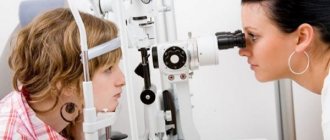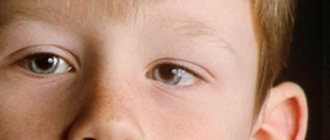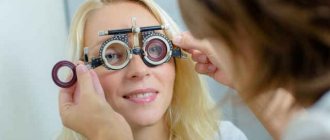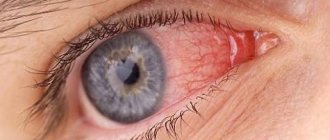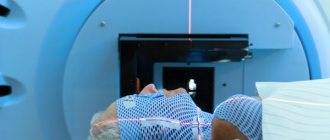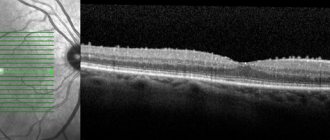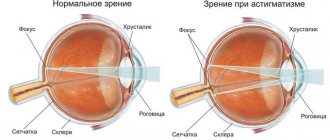Amblyopia is a progressive decrease in visual acuity in the absence of structural changes directly in the visual analyzer.
A characteristic feature of this disease is the reversibility of functional changes at the initial stages. Vision correction with glasses or contact lenses is not possible for amblyopia, which is another feature. Amblyopia is quite common and is more common in childhood.
There is another popular name for amblyopia – “lazy eye”. The disease received this name for a reason, since during its development the entire visual load falls on one dominant eye, while the second is practically not included in the vision process.
It turns out that both eyes see, but the picture is obtained with significant differences. It becomes difficult to combine the resulting images into a single, three-dimensional image, as a result of which the work of the weaker eye is suppressed, and the brain perceives information only from the “dominant” eye.
The exclusion of one eye from visual perception results in a violation of binocular vision, which leads to incorrect determination of the location of objects and the receipt of an incomplete volume of the perceived image. The dominant eye experiences overstrain, resulting in headaches, pain and discomfort in the eyes.
Amblyopia in adults: causes
Among the possible triggering factors for the development of amblyopia, according to statistics, the leading ones are:
- strabismus (the most common cause);
- pronounced degree of refractive error (myopia, farsightedness, astigmatism);
- anisometropia - a significant, over three diopters, difference in visual acuity between the right and left eyes;
- an opaque obstacle in the through path of the light flux in the eye (cataract, cloudy lens, post-traumatic scar, etc.).
Why does the eye become lazy?
Amblyopia most often develops in early childhood, when binocular vision is formed - between the ages of six months and 9–10 years. Based on the reasons that prompted the brain to turn off the weak eye, several types of amblyopia are distinguished:
- refractive – occurs against the background of severe myopia, farsightedness and astigmatism with a large difference in the refractive power of the eyes (from 3D);
- deprivation – caused by difficult access of light to the retina due to damage to the vitreous body, cicatricial changes in the cornea, retinopathy of prematurity, cataracts, cataracts, drooping lower eyelid, etc.;
- dysbinocular – caused by inhibition of the visual function of the defective eye due to strabismus and nystagmus;
- psychogenic – provoked by stress and psychological trauma. This is the only type of amblyopia in which vision is completely restored without treatment - it is enough to eliminate the effect of the psychotraumatic factor.
| Impaired binocular vision with amblyopia: the brain ignores pictures from the visually impaired eye |
| Congenital cataracts are a common cause of amblyopia |
| The habit of squinting is a sure sign of lazy eye syndrome |
| Strabismus and amblyopia often go together |
Psychogenic amblyopia differs from other forms of the disease by a sharp decrease in visual acuity, and in most cases both eyes are affected. In parallel, other visual disturbances may be observed - narrowing of the field of view, photophobia, impaired color perception.
Signs (symptoms) of amblyopia
In the early stages of development, amblyopia may be asymptomatic or with minimal visual discomfort. However, gradually a person begins to perceive the depth of space worse, assess the distance to observed objects and their relative position, and coordinate complex movements. There may be an “unexplained” headache, rapid fatigue when working hard with small details, when reading, etc. Sometimes patients find that by squinting one (as it later turns out, amblyopic) eye, they see much better than with two open eyes.
At the initial appointment with suspected amblyopia, the ophthalmologist will definitely collect the most detailed medical history - heredity, previous injuries, neurological status, complaints, estimated “length of experience” of the disease, and many others. A thorough ophthalmoscopic examination will be performed; If necessary, the doctor will prescribe additional diagnostic procedures (for example, MRI or ultrasound).
One of the decisive factors determining the prognosis for amblyopia is age. If, in general, the functional degradation of the amblyopic eye is still reversible at the time of diagnosis, treatment should begin as quickly as possible. The greatest effect is achieved in childhood, while the main structures of the eye are at the stage of dynamic development, under the conditions of early diagnosis, timely elimination of causes and completion of all necessary therapeutic courses by the beginning of schooling. Some sources indicate 12 years of age as the limit (for effective intervention), while others emphasize cases of successful treatment of amblyopia even in elderly patients.
Innovative methods for correcting amblyopia
Sometimes the material of the occlusive dressing is very irritating to the skin and cornea. In such cases, the occlusion effect is achieved by instilling atropine into the dominant eye.
The latest word in gentle correction of amblyopia is ViDi smart glasses with liquid crystal lenses in a stylish, streamlined frame. In appearance, they resemble sports glasses, which are adored by celebrities - Rihanna, Kim Kardashian and the Hadid sisters. Pulsating the darkening of the glass opposite the dominant eye helps adapt to the treatment by gradually increasing the duration of occlusion. A mirror coating is applied to the outer surface of the glass, so that the darkening of one of the light openings will go unnoticed by others, and the child will not have to endure ridicule from peers. By the way, there is no need to wear training glasses all the time - five hours a day is enough!
| Board games are a great exercise for the lazy eye! |
| Stylish ViDi smart glasses successfully treat amblyopia and childhood complexes |
Twice a year, photostimulation therapy is recommended for children with amblyopia - courses of stimulation of the retina of the amblyopic eye with flashes of pulsed light or a defocused beam of a helium-neon laser. If necessary, electrical stimulation of the optic nerve is also prescribed. Once every two to three months you should be examined by an ophthalmologist to monitor the dynamics.
For deprivation and dysbinocular amblyopia, eye surgery is indicated - the sooner the better. However, surgery does not replace conservative treatment. After removing the mechanical obstacles, the amblyopic eye will have to be re-taught to see correctly. It won't be easy at first, but the results will be worth it. Progressive amblyopia leads to the development of strabismus and distorts the perception of three-dimensional space. Don't let your child lock himself in a flat world - fight for good vision together!
Treatment of amblyopia in adults
Therapy should be etiopathogenetic in nature, i.e. The priority task is to eliminate the causes of amblyopia - be it cataracts, ptosis of the upper eyelid, obvious or hidden strabismus. In some cases, ophthalmic surgery is inevitable, in others conservative methods are sufficient. For example, if the cause is a refractive error, it will need optical correction with glasses or contact lenses.
Many schemes and specific methods for treating amblyopia have been developed (occlusion, penalization, hardware-training stimulation, computerized techniques, photostimulation, eye drops, etc.). Their set is always strictly individual; it is determined by the doctor on the basis of anamnestic information and the clinical picture. However, in any case, therapy is aimed at:
- forced re-activation of the amblyopic eye, its inclusion in the processes of constructing a visual image;
- restoration of refractive (refractive and focusing) functions to the maximum possible degree in each individual case;
- restoration, training and strengthening of fusion automatisms and reflexes, i.e. restoration of binocular vision;
- prevention of possible side effects of treatment for a healthy eye and relapses for an amblyopic eye.
Our ophthalmology center has a full range of modern high-tech equipment used in world practice for the diagnosis and treatment of amblyopia: devices such as “Synoptophore”, “Monobinoscope”, other stimulators and amblyotreners. Amblyopia is effectively treated here at any age.
MedPortal.org article: Amblyopia: how to teach the “lazy eye” to work.
We talked about “lazy eyes” and scientific developments of the 80s, the idea of which Canadian scientists came to only 2 years ago, with an ophthalmologist of the highest category, candidate of medical sciences Efim Konstantinovich Sorochkin.
MedPortal: Efim Konstantinovich, how do you explain to the average person what amblyopia is?
Amblyopia is a very beneficial disease in the sense that it is highly treatable. If you prescribe treatment correctly and work hard, which requires a certain investment of time and effort, then recovery should reach almost 100%. Why am I not afraid to talk about 100%? Because this is a functional disease (i.e. there is no organic damage to the organ of vision - scars, tumors, opacities), and reduced function can always be restored. If a function of any organ is not in demand, it loses its functionality due to inactivity. For example, in people who remain immobile for a long time, the ability to move is lost, muscle mass decreases, calcium is washed out of the bones, and the person has to be taught to move again. The main function of the eye is to see. If it is not in demand, it decreases. If the eye is not forced to work, it will see poorly.
MedPortal: Why does amblyopia occur?
The causes of amblyopia can be different: strabismus, a significant degree of farsightedness, myopia, astigmatism. You can simply block the path of light rays to the retina - and vision will deteriorate. All refractive media of the eye are normally transparent: starting with the cornea, this is the surface membrane, then the lens, this is the lens inside the eye, then the vitreous body. If a congenital or acquired impairment of transparency occurs in any structure as a result of injury, hemorrhage, or inflammation and one segment becomes cloudy, the light beam will no longer reach the retina. This occurs when there is clouding of the cornea (cataract), clouding of the lens (congenital, acquired, traumatic or radiation cataract after exposure to ionizing radiation), hemorrhage into the vitreous body. If the cause that is blocking the passage of light rays into the eye is not eliminated, and then special treatment is not prescribed, the person will remain without vision in that eye. If one eye does not see or sees much worse than the other, full binocular stereoscopic vision is impossible. The perception of the world becomes different.
MedPortal: How long does it take for amblyopia to develop? For example, a child was diagnosed with cataracts, operated on and the problem was corrected. Will he have amblyopia?
If the cataract is congenital, then the child will have reduced vision in that eye. Even in the womb, the child already perceives rays of light, of course not to the same extent as after birth. We operated on children with congenital cataracts at the earliest possible stage, as soon as the anesthesiologists believed that the child would tolerate anesthesia.
MedPortal: At what age can a child be diagnosed with amblyopia?
A pediatrician can notice amblyopia during the first examinations of a newborn child. The presence of a problem is indicated by different pupil colors (which may be a sign of cataracts), and unstable eye position.
MedPortal: Does amblyopia always develop with strabismus?
No, but in most cases. When the eye begins to squint, double vision (diplopia) occurs. It is very painful, accompanied by headache and nausea. To suppress double vision, the human brain “turns off” the squinting eye. This is when amblyopia develops.
MedPortal: What is the treatment for amblyopia?
One of the main principles in the treatment of amblyopia is to “eliminate the competitor.” That is, completely close the eye that sees better so that the entire visual load falls on the amblyopic eye. Usually the child actively resists this: he is used to seeing comfortably, but when a good seeing eye is closed, it becomes difficult for him to read and play. This is also a psychological problem. You should always close the better seeing eye. This is easy to explain: for example, there are two identical organs, one of which works better, and the second - worse. The body always gives preference to the one that works better, ignoring and even suppressing the worst.
MedPortal: How long should an eye with amblyopia be closed?
There is the concept of “total direct occlusion” - this is the complete closure of the better seeing eye. The main mistake of doctors who treat amblyopia is that they feel sorry for the child and recommend closing the eye for “half an hour a day” or two hours. These are all half measures. Because during the remaining 6-8 hours of active work during the day, the better-seeing eye again takes on the entire load, and the amblyopic eye turns off again. The best results in the treatment of amblyopia can be obtained if you close the good-seeing eye completely for the entire treatment period. There is a psychological complexity to this. But those who endure it achieve results. In my practice, patients with visual acuity of 0.01 (with such vision a child can distinguish fingers and count them at a distance of 50 cm from the eyes) restored their vision to normal within 8-9 months. We have specialized kindergartens in our country; there are two of them in Minsk - on Miroshnichenko Street and on Rokossovsky Avenue. They work with children and try to restore their vision before school, so that the child feels complete at school. The main stages of treatment: first, completely close the eye that sees better. Secondly, if necessary, carry out complete vision correction using glasses, contact lenses, or surgical treatment. Third, carry out light stimulation and give a greater visual load to the amblyopic eye.
MedPortal: How big should the load be, how can you train the “lazy eye” with amblyopia to restore vision?
The load should be physiological. It is physiological for muscles to contract and move weights, for the eye to perceive light waves and examine objects. There are physiotherapeutic methods of treatment, which are based on the effect on the eye of heat, acupressure, electric current, and acupuncture. This is not physiological. Therefore, methods of light exposure to the eye were proposed - flashing according to Avetisov, according to Bangerter, which stimulate the center of the retina, where the macula, or macula, is located. It is responsible for visual acuity, perception of color and shape of an object. Therefore, the light stimulus for this zone must include the color and shape of some object. And one more thing - after some time, stationary objects begin to be suppressed and the eye does not see them. In order for a person to be able to look at stationary objects in life, the eye has a physiological device - nystagmus (small twitching of the eyeball that constantly shifts the image). A continuous light stream stimulates the organ of vision worse, so pulsed light exposures are used to treat amblyopia.
MedPortal: Efim Konstantinovich, please tell us about your development for the treatment of amblyopia.
The result of my many years of work was the creation of the amblyostimulator “Aist-01LK” and the computer game “Aist-PIK”. The operation of the amblyostimulator "Aist-01LK" takes into account the basic physiological needs of the eye. For highlights, red is used as the most effective color. To avoid adaptation to one color, red is replaced by green. When there is light, the child sees mosaic figures that change and flicker with a certain frequency. We tried to make the device as accessible to the population as possible; we did not use timers, sound signals or other effects that could increase the cost of the device without increasing its efficiency.
MedPortal: Can the device be used at home or do you need to go to a clinic for procedures?
We have made the device as accessible as possible to the population – both in price and in terms of use. We recommend treatment at home 2-3 times a day, with visits to ophthalmologists only for follow-up examinations. This saves both time and money.
MedPortal: Canadian scientists 2 years ago said that you can train your eyes by playing Tetris. Did you suggest this much earlier?
Yes, we have developed the Stork-PIK program. Along with the treatment of amblyopia, after the vision in the child’s amblyopic eye rises to 0.3 - 0.4, the program is also used to train binocular vision, which makes it possible to look with two eyes at the same time and perceive a single image. The principle of the game is to move flashing red and blue figures across the screen, which the child looks at through special glasses - with red and blue glass. One eye sees only blue elements, the other only red. To play, both eyes must work together. The idea of treating amblyopia using the game “Tetris” was voiced by Canadian scientists two years ago; by this time we had already completed all clinical trials and mass-produced “Aist-PIK”, and the technique itself was first presented in the invention of 1988. Link to article: https://medportal.org/interviews/ambliopiya-kak-nauchit-lenivyj-glaz-rabotat.html
"Trigger" of hysterical amblyopia
In the hysterical form of amblyopia, visual symptoms arise as a result of strong emotional experience, stress, clinical depression and other psycho-emotional factors. The physiological reaction is caused by mental processes that occur in the cerebral cortex. In response to experiences, the visual cortex blocks or inhibits the process of visual perception. As a rule, along with unilateral loss of vision, patients with this diagnosis also experience other symptoms: sensitivity to light, reduced color perception, and the appearance of “blind spots” in the visual field.
Prevention
Prevention of the disease involves regular medical examinations, starting from the first month of life.
The newborn should receive a thorough eye examination within the first few days after birth. The doctor will check for any obvious abnormalities related to the structure of the child's eyes or eyelids.
Amblyopia cannot be prevented by adjusting your diet, daily routine, or walking in the fresh air. These preventive measures in no way affect its development, and therefore will not help prevent it.
The development of the disease can be prevented if:
- spend less time at the computer;
- make good lighting;
- undergo regular examination;
- control strabismus;
- perform eye exercises (especially for schoolchildren under increased stress).
